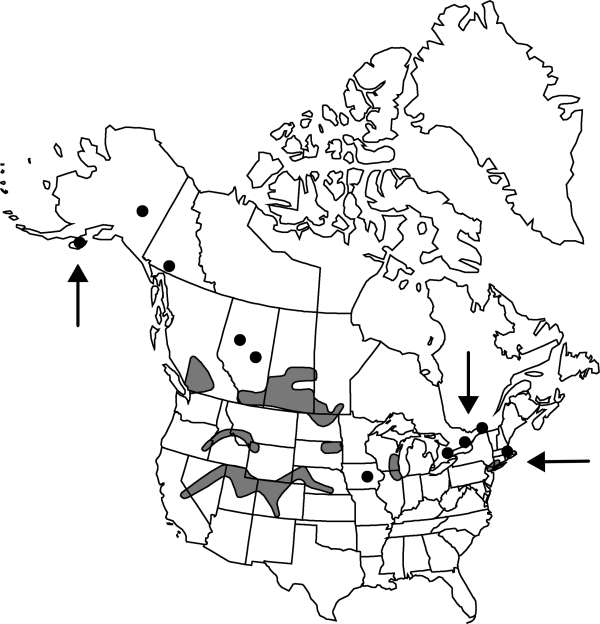Difference between revisions of "Atriplex hortensis"
Sp. Pl. 2: 1053. 1753.
FNA>Volume Importer |
FNA>Volume Importer |
||
| Line 27: | Line 27: | ||
|elevation=0-2200 m | |elevation=0-2200 m | ||
|distribution=Alta.;B.C.;Man.;Ont.;Que.;Sask.;Yukon;Alaska;Calif.;Colo.;Conn.;Idaho;Ill.;Ind.;Iowa;Mass.;Minn.;Mont.;Nebr.;Nev.;N.J.;N.Y.;N.Dak.;Oreg.;S.Dak.;Utah;Wash.;Wis.;Wyo.;Asia. | |distribution=Alta.;B.C.;Man.;Ont.;Que.;Sask.;Yukon;Alaska;Calif.;Colo.;Conn.;Idaho;Ill.;Ind.;Iowa;Mass.;Minn.;Mont.;Nebr.;Nev.;N.J.;N.Y.;N.Dak.;Oreg.;S.Dak.;Utah;Wash.;Wis.;Wyo.;Asia. | ||
| − | |discussion=<p>Atriplex hortensis has been widely grown as a potherb, has escaped from cultivation, and is now established especially in moist ruderal sites. It is easily distinguished by its rounded, samaralike, entire, and smooth fruiting bracteoles, and the presence of two kinds of pistillate flowers, the one enclosed by bracteoles and lacking sepals, the other without bracteoles but subtended by sepals.</p><!-- | + | |discussion=<p><i>Atriplex hortensis</i> has been widely grown as a potherb, has escaped from cultivation, and is now established especially in moist ruderal sites. It is easily distinguished by its rounded, samaralike, entire, and smooth fruiting bracteoles, and the presence of two kinds of pistillate flowers, the one enclosed by bracteoles and lacking sepals, the other without bracteoles but subtended by sepals.</p><!-- |
| − | --><p>Atriplex nitens (see list of excluded taxa) is distinguished from A. hortensis in Flora Europea (P. Aellen 1964b) by having leaf blades densely white scurfy beneath, the distal surface lustrous, as opposed to green and dull for A. hortensis. Occasional specimens, treated here as A. hortensis, have leaves somewhat scurfy.</p> | + | --><p><i>Atriplex</i> nitens (see list of excluded taxa) is distinguished from <i>A. hortensis</i> in Flora Europea (P. Aellen 1964b) by having leaf blades densely white scurfy beneath, the distal surface lustrous, as opposed to green and dull for <i>A. hortensis</i>. Occasional specimens, treated here as <i>A. hortensis</i>, have leaves somewhat scurfy.</p> |
|tables= | |tables= | ||
|references= | |references= | ||
| Line 53: | Line 53: | ||
|publication year=1753 | |publication year=1753 | ||
|special status= | |special status= | ||
| − | |source xml=https://jpend@bitbucket.org/aafc-mbb/fna-data-curation.git/src/ | + | |source xml=https://jpend@bitbucket.org/aafc-mbb/fna-data-curation.git/src/8f726806613d60c220dc4493de13607dd3150896/coarse_grained_fna_xml/V4/V4_627.xml |
|genus=Atriplex | |genus=Atriplex | ||
|subgenus=Atriplex subg. Atriplex | |subgenus=Atriplex subg. Atriplex | ||
Revision as of 18:29, 18 September 2019
Herbs, green to yellowish or reddish, 5–15(–25) dm, glabrous. Stems erect, mostly branched. Leaves mostly opposite or mostly alternate; petiole 0.3–4+ cm; blade green on both sides, ovate or ovate-lanceolate to cordate-hastate at base, 15–180 × 8–135 mm, margin entire or more rarely irregularly toothed or lobed, apex attenuate to acuminate or rounded. Inflorescences of spikes disposed in leafless panicles. Staminate flowers 5-merous. Pistillate flowers dimorphic, some ebracteolate and with 5-parted perianth, others without perianth enclosed by a pair of sessile or very shortly stipitate bracteoles. Fruiting bracteoles samaralike, orbicular to oval or ovate, compressed, 5–18 mm, united only at base, entire, faces smooth. Seeds of ebracteate flowers black, horizontal, convex, 1–2 mm wide, lustrous; those of bracteolate flowers olivaceous brown, vertical, flat, 3–4.5 mm wide, dull. 2n = 18.
Phenology: Flowering summer–fall.
Habitat: Roadsides, canal and stream banks, lake shores, disturbed sites and gardens
Elevation: 0-2200 m
Distribution

Alta., B.C., Man., Ont., Que., Sask., Yukon, Alaska, Calif., Colo., Conn., Idaho, Ill., Ind., Iowa, Mass., Minn., Mont., Nebr., Nev., N.J., N.Y., N.Dak., Oreg., S.Dak., Utah, Wash., Wis., Wyo., Asia.
Discussion
Atriplex hortensis has been widely grown as a potherb, has escaped from cultivation, and is now established especially in moist ruderal sites. It is easily distinguished by its rounded, samaralike, entire, and smooth fruiting bracteoles, and the presence of two kinds of pistillate flowers, the one enclosed by bracteoles and lacking sepals, the other without bracteoles but subtended by sepals.
Atriplex nitens (see list of excluded taxa) is distinguished from A. hortensis in Flora Europea (P. Aellen 1964b) by having leaf blades densely white scurfy beneath, the distal surface lustrous, as opposed to green and dull for A. hortensis. Occasional specimens, treated here as A. hortensis, have leaves somewhat scurfy.
Selected References
None.
